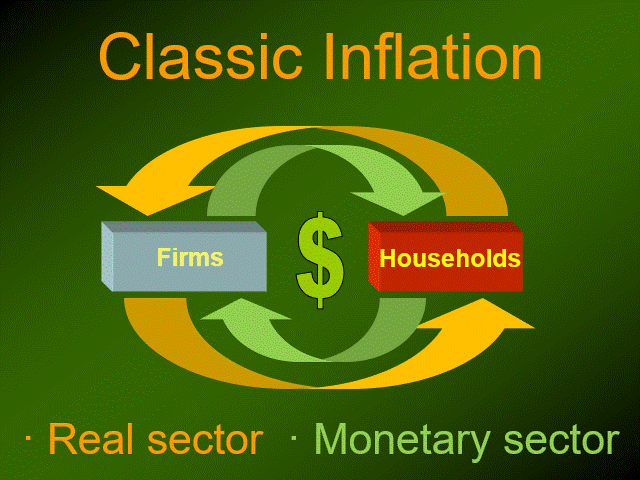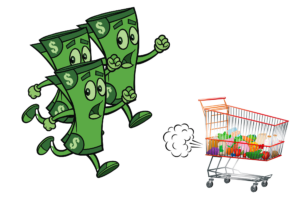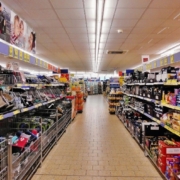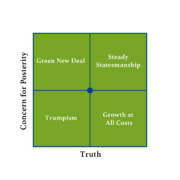A Perfect Storm for Inflation: COVID, Loose Money, and Putin
by Brian Czech
The current bout of inflation should be no surprise to steady staters. We have national and global ecosystems pushed to the limits by population and economic growth. At the same time, we have monetary authorities and heads of state—neoclassically oblivious to limits—eager to stimulate the economy with loose money. It’s a recipe for inflation.

A simple warning issued in March 2020: full tweet here.
We tweeted all the way back in March 2020 that inflation was coming. If it wasn’t already in the works from COVID-caused supply shocks, President Trump’s fiscal stimulus (CARES Act) put it there. President Biden’s American Rescue Plan came a year later (and one year ago today). These fiscal policies were politically prudent and remedial for many, but they fanned the flames for inflation.
And now we have a two-pronged supply shock emanating from the steppes of Eastern Europe. Russian energy and Ukrainian grain (plus Ukrainian energy and Russian grain) are now sanctioned, restricted, and constricted. The Russian threat also puts even more pressure on NATO countries and Russia to let loose with yet another round of money.
All this creates a perfect storm for an episode of inflation that will be long-lasting and global. If the war in Ukraine spirals further out of control for a protracted period, this inflationary period could become one of the worst in world history. It’s time to take a 21st century look at the fundamentals of inflation, and plan for the storm ahead.
Inflation
Inflation is one of those confounding concepts—a bit like gravity—that is at once easy to understand and subjected to baffling analysis. Fortunately, a perfectly clear and memorable phrase can be used to grasp it: “too much money chasing too few goods.” As such, you tend to know it when you see it. If you’re old enough to buy a beer, you’ve already seen plenty of it.

Too much money chasing too few goods.
Economists distinguish “demand-pull” inflation from “cost-push” inflation. These are two sides of the same coin (so to speak), but the phrase “demand-pull” connotes the “too much money” aspect of inflation, while “cost-push” connotes “too few goods.” Yes, the distinction has a chicken-and-egg aspect: Given either pull or push, inflation is hatched.
Given that “too much money” and “too few goods” are aggregate measures, inflation is a macroeconomic phenomenon, but sometimes sectoral price increases are conflated with inflation per se. If everyone suddenly wants a pet rock, the price increases, but that’s not inflation, demand-pull or otherwise. Similarly, if rocks become harder to find, the price increases, but that’s not inflation, cost-push or otherwise. Consumers can turn to cheaper pet sticks or pet ants, or simply eschew the pet sector entirely. Prices don’t go up across the board. The price of pet rocks is simply a microeconomic phenomenon reflecting the supply and demand thereof.
It makes little sense, then, to talk of inflation exclusively in terms of pet rocks, widgets, or even lumber. It would seem that the proper way to measure inflation would be with a relatively full basket of goods, monitoring the cumulative price over time. That is, in fact, what the Bureau of Labor Statistics (BLS) does with the Consumer Price Index (CPI).
The BLS doesn’t need to include every single good and service stemming from the thousands of industries identified in the North America Industry Classification System. You might, for example, leave out the pet rocks. Surely, however, you wouldn’t want to omit groceries and gas, would you?
Yet that is precisely what economists at the Federal Reserve do with the curious concept of “core inflation,” which accounts for the prices of most goods and services except food and energy. For ecological economists, “core” sounds like a misnomer when the most essential goods are omitted. The rationale of economists at the Fed is that food and energy prices are more volatile than those of other goods; the core should be more stable. A less volatile core measure is supposed to make things easier for forecasting and goal-setting purposes, but it’s hard not to suspect some kind of political fish lurking in the waters circa 2000, when the Fed adopted the concept.
The notion of a non-volatile inflation metric is a bit like thinking, “When we weigh the patient, let’s not include the fat in the midsection, because that area jiggles around more than the rest of the body.” If it’s not a political red herring, the notion of a foodless, energy-absent core measure of inflation is yet another example of the conventional economics profession overlooking the primacy of the agricultural and energy sectors at the trophic base of the economy.
When you think about inflation, do you think it wise to omit grocery bills and gas prices? I didn’t think so. Neither would moms, car drivers, or eaters. (Have I left anyone out?)
Century of Supply Shock
In this article, “supply shock” takes on two meanings. We have the typical meaning of a sudden and steep decline in the supply of a resource, such as an oil shock resulting from an embargo. Of immediate concern, though, is the absolutely macroeconomic scenario I wrote about in Supply Shock: Economic Growth at the Crossroads and the Steady State Solution. A suite of essential resources are dwindling rapidly, although unobserved and out of mind for most. Soils, groundwater, sawtimber, fisheries, various minerals, and conventional energy resources become ever scarcer as the global population grows and the stocks of these resources are eroded, compromised, or outright liquidated. We’re entering an era or a century of Supply Shock, corresponding with other labeled periods such as the Anthropocene and Sixth Great Extinction.
Some may argue that, by definition, the ongoing, background declines of natural resources are trends, not shocks. That would be a fair argument if we were talking about one resource, but supply curves across the board are moving inward, and faster by the decade. Soon enough, the cumulative effect will be stunning to generations accustomed to dealing piecemeal with temporary supply issues, such as an oil embargo here or a fishery collapse there.
Furthermore, economists and politicians are still living in a fantasyland, expecting new technologies to save the day. By the nature of their professions, they tend to be older folks who’ve seen many a 20th century problem overcome with new technology. Unfortunately, most of them seem to have little sense that the low-hanging technological and thermodynamic fruits have been picked, leaving the shelves barer and less accessible for this century. The impending wake-up call will be quite a surprise to them, as it will be for the media who cover them.
For the broader public then, which in turn gets its fuzzy understanding of economics from the mainstream media, the combination of widespread shortages and the limitations of technology will suddenly appear overwhelming. People (exceedingly few of whom read outlets such as the Herald) will be wondering, “Why weren’t we hearing about this in advance?” They’ll be shocked.
In other words, while the economy of nature is undergoing its Sixth Great Extinction, the human economy is entering the Century of Supply Shock. The money supply will be chasing fewer goods, and the stage will be consistently set for inflation, just waiting for feckless fiscal and monetary actors.
Fiscal Stimulus

President Biden touting the American Rescue Plan. (CC BY-NC-ND 3.0, Eric Haynes)
Thus far we’ve had three rounds of economic impact payments—aka “stimulus checks”—to buffer the majority of American citizens from the economic impacts of COVID. Direct payments totaling approximately $867 billion have been or will yet be made pursuant to the CARES Act (2020), the Consolidated Appropriations Act (2020), and the American Rescue Plan (2021). $456 billion is somewhat attributable to Trump (who signed the first two bills), and $411 billion to Biden (who signed the American Rescue Plan). The total is not far from a trillion dollars; roughly five percent of American GDP and well over one percent of global GDP.
Where did such a huge sum of money come from? While it’s a little more complicated than this, the money is mostly debt. The CARES Act, for example, was signed by Trump on March 27, 2020, well into the fiscal year, which itself was budgeted for long before COVID-19 was even identified. In other words, the money came out of thin air, much like COVID.
That means we instantly had an inflated money supply, by definition, chasing goods already becoming scarce in the age of Supply Shock. Demand-pull and cost-push forces were already at work, with the depths of the COVID pandemic yet to come. The subsequent two fiscal stimuli packages were more planned and better budgeted, but still “financed” largely by debt, conducive to further inflation.
COVID-Caused Recession
The COVID-caused recession brings us back to the “fewer goods” part of the inflation equation. While COVID-19 triggered an initial wave of positive demand shocks for such home-bound supplies as toilet paper, pasta, and paper towels, negative demand shocks slammed the hospitality, entertainment, and certain retail industries. (Imagine being an airline or a dentist during the depths of the pandemic.)

Sports and entertainment sectors took a heavy hit during the COVID pandemic.
More importantly, virtually all sectors were slowed by supply chain issues resulting from workplace shutdowns and an erosion of the labor force due to covid deaths, illness, and exposure avoidance. The ultimate avoidance tactic was retirement or resignation. Millions of workers—especially the very young and the retirement-eligible—learned they didn’t necessarily need to work. Not when they were receiving stimulus checks while saving the expenses of commuting and parking. The Great Resignation is “still in full swing,” too.
Only higher-income individuals and families weren’t eligible for stimulus checks. That means those who received the checks were fairly dependent upon them for essential goods and basic services; the checks weren’t deposited in savings accounts. The demand for such goods (most notably food) is price-inelastic, too, so the sudden glut of debt-based money was bound to settle into the prices at grocery stores, convenience stores, and pharmacies. That’s demand-pull inflation.
As if all that wasn’t enough, Russian President Vladimir Putin ordered the invasion of Ukraine on February 24, 2022, setting in motion supply shocks at the trophic base of the economy.
The Volatile Mix of Gas and Grain
The relevance of trophic levels in the structure of the economy is about to take center stage in the tragic play called Inflation 2022. Almost one-fourth of the world’s wheat and nearly a third of its barley comes (normally) from the grain belt stretching from western Ukraine through southwestern Russia. Ukraine alone provides about 16 percent of the world’s corn. Significant shares of rye, soybeans, potatoes, vegetable oils (most notably sunflower), and numerous other food staples emanate from this breadbasket of Europe.
Ukrainian agricultural production and transport will be severely challenged by the Russian invasion. The vast majority of wheat in this part of the world is winter wheat; planted in fall and harvested in summer. If the war remains hot into the summer, with most Ukrainian men—and many women as well—occupied with fighting, farming will suffer. Farmers are also facing shortages (high prices) of fertilizers and pesticides at a time when income flows and even basic financial operations will be difficult to maintain. Similar problems will be faced in all of the major Ukrainian agricultural operations. For what surplus might remain, export routes along the Black Sea are cut off.
In addition, Russian commodity exports have been banned, not only by receiving countries but, in retaliation, by Putin himself. That means grain from the USA and Canada, along with lesser grain belts in Mexico, Argentina, Chile, Brazil, China, India, Australia, Kazakhstan, and Turkey will be needed to feed the world. Wheat and corn prices are already skyrocketing, and supply shocks from the “chernozem” belt of Ukraine/Russia are reverberating into the price points for all cereal grains including rice.
Meanwhile, as steady staters know, money originates from the agricultural surplus that frees the hands for the division of labor unto all other sectors. That’s the trophic theory of money, which links the real (trophically structured) economy with the monetary sector in a manner that makes inflation easier to understand. The trophic theory of money implies that, if agricultural surplus declines, less real money is “authorized.” When the agricultural decline is sudden, as with a pronounced, cereal grain supply shock, the nominal money supply is just as suddenly inflated. And this is precisely the current situation.
In other words, no one should be wishfully thinking that inflation can be confined to the grocery store. All the money in the world—real money that is, adjusted for inflation—stems from agricultural surplus (or more generally, food surplus, which at this point in history is all about cereal grains). This underscores the truly macroeconomic aspect of inflation. It’s not only market forces that reallocate demand into different sectors, spreading price increases along the way. Rather, the money supply—same supply used for all goods and services—is inflated from the moment the agricultural surplus declines. If it takes a little longer for prices of some goods and services to increase, relative to others, the difference can be chalked up to the trophic procession of production from agro/extractive at the base to heavy manufacturing (and rough services) in the middle to light manufacturing (and refined services) at the higher levels. That’s why, in these early stages of the Russian invasion, commodity prices have increased faster than others.
Of course, one such commodity is energy; most notably crude oil and natural gas, supplies of which have also and suddenly been disrupted by the war. These are probably the most widely reported commodities for several important economic, environmental, and geopolitical reasons. I bring them up here primarily to highlight their linkage to agricultural production. Cereal grain production in the chernozem belt has become heavily mechanized, and the trend continues. As if all the other hurdles weren’t enough for Ukraine and Russian grain production and export, rapidly rising fuel prices add further to the cost-push inflationary pressures.
As global leaders, think tanks, and corporations analyze or plan for the future, they may want to pay close attention to the economic effects of the war in Ukraine. We’re learning a painful lesson about how disastrous things can become when we push beyond reason for growth. The planet can only produce so much food, oil, natural gas, and all the other resources. Yes, renewables are coming online for powering electricity grids, but the wheat combines of the Eurasian steppe don’t turn on a dime, and renewables may never cut it for the type of sheer horsepower needed for cultivating the chernozem of Eurasia, North America, or any other grain belt.
The money supply, on the other hand, can become inflated overnight, impacting the lives of billions of people in short order and with long-lasting consequences for families and businesses.
The warning signs are clear now, and they’re not all about the environment. The biggest, newest red flag on the planet is inflation, the dreaded tax-in-effect that hits everyone, everywhere. In the Century of Supply Shock, inflation will always be nipping at our heels, ready to run wild with any agricultural supply shock, ready to run loose with any feckless “stimulus,” fiscal or monetary. It’s yet another warning that we need a new approach: degrowth toward a steady state economy.
 Brian Czech is the executive director at CASSE.
Brian Czech is the executive director at CASSE.






Spot on, Brian. Thanks for the analysis. We Americans often overlook the importance of the agricultural sector, & especially the crucial damage done to soil ecosystems around the world since the advent of petrochemical applications to farm fields. Main Street is indeed in for a shock if we humans don’t do more to mitigate soil degradation. Keep on truckin’ with the Steady State message.
Happy Trails,
Scott H.
I concur with Scott, Brian. I also agree that “degrowth towards a steady economy” is a big part if not the most important part of how we respond in the long run to what you analyze so well. However, I’m concerned that not enough attention is being paid to the role of conventional money in all this. I agree, that the basis of any economy is that resource base from which we get our food supply as you rightly point our. But, it is how we actually organize ourselves which has an even bigger impact in how we develop that resource base, whatever it is. And this is core politics. Right now our capitalistic, pro-growth, market based economy( and this is now a world integrated system) requires a debt created money( as you also nicely point out) which in turn fuels and “requires” more throughput growth in terms of commodities and services produced. In short, our economy functions to mal-distribute and concentrations capital( money) as political power; it puts the cart of provisioning behind the horse of money. We need to reverse this and to create accounting systems that use different forms of currencies that facilitate the production of what need and to foster reformation of local communities that would be empowered to take care of the natural world in which we are embedded. How we do this will require very creative and innovative thinking. But, the steady state model is a core feature of this kind of economy.
Sorry, I meant: we put the cart of provisioning in front of the horse of finance, so that capital concentration and accumulation in terms money rules the economy at our lives.
Enjoyed the read, An effect of all this recession dodging stimulus has been asset price inflation.
Modern stimulus seemed to be introduced after the dotcom bubble burst to avoid a recession, near zero interest kicked the can down the street by creating debt to keep the party going. Low interest and stimulus then blew up the global property bubble which bust in 07. More QE stimulus after the property bust has enabled consumers to borrow – drive the consumers boom to indebten themselves – so that they can overspend to shore up a potentially contracting economy.
Consumers now are overburdened with debt, their transient spending having moved the wealth, transferred through their buying, to the wealthier investors, widening the wealth/debt gap. Those investors now having made their gains are awash with a sea of cash pushing up share prices, particularly the trendy tech sector. Its like the dotcom bubble all over again. There’s too much cash at the top, having nowhere else to go chasing investments that will struggle to deliver returns, because the underlying consumers that prop up the house of cards are weak – too indebted. Answer, lets indebten them some more, 100 year mortgage terms ahead…don’t think so. A reset button must be hit, sensible central bankers might suggest some debt forgiveness along with higher tax to transfer the cash back to the bottom. Destabilising inflation, like an economic earthquake in slomo, might erode consumer debt, however in doing so might shake down the whole house of cards. The crises might precipitate a change to a non growth driven model in its aftermath.
Great analysis. I would just add that the 2nd law of thermodynamics guarantees that energy price increases will push input prices higher for every good and service, bar none. And I don’t know anybody who doesn’t eat. So food and energy are the real “core inflation.” And the other factor is dysfunctional governments in democracies in the age of propaganda, climate denial and lies. Governance really matters. You can see that by comparing Norway and Singapore to Nigeria and Angola. The latter two have more natural resources but are poorer due to bad governments that are a legacy of colonialism and corporate exploitation.
I wish this article hadn’t continued to use the incorrect nickname “stimulus checks” for the COVID relief/impact payments. As was pointed out, many Americans used these for routine needs. I did. My income is very low due to involuntary long-term unemployment caused by job discrimination. I used the money for necessities like new sneakers, haircuts, paying a bill all at once instead of monthly installments with extra fee for not paying in full, and a new computer. If we had true full employment in the USA, I’d have the career I got my education for, and wouldn’t have had to eagerly look forward to these checks, and not be hurting now without more in the future. Tens of millions more Americans would be much better-off financially and career-wise. But true full employment would not be something to fear as a cause of more inflation. There would result more equity in incomes and wealth. And our governments wouldn’t have to borrow so much money to help the downtrodden in various ways. Not to forget that people with their parts of solutions to various challenges would be able to contribute them – instead of being excluded by job discrimination and the rulers of the power structure. http://EFTornadoSafeHome.com.